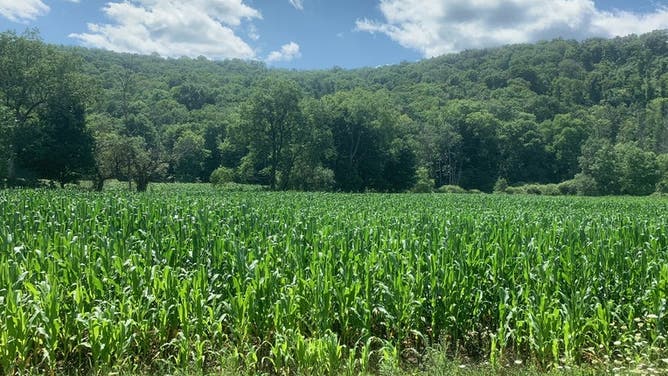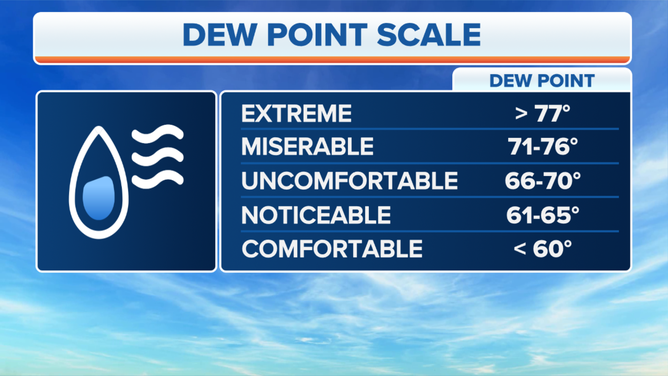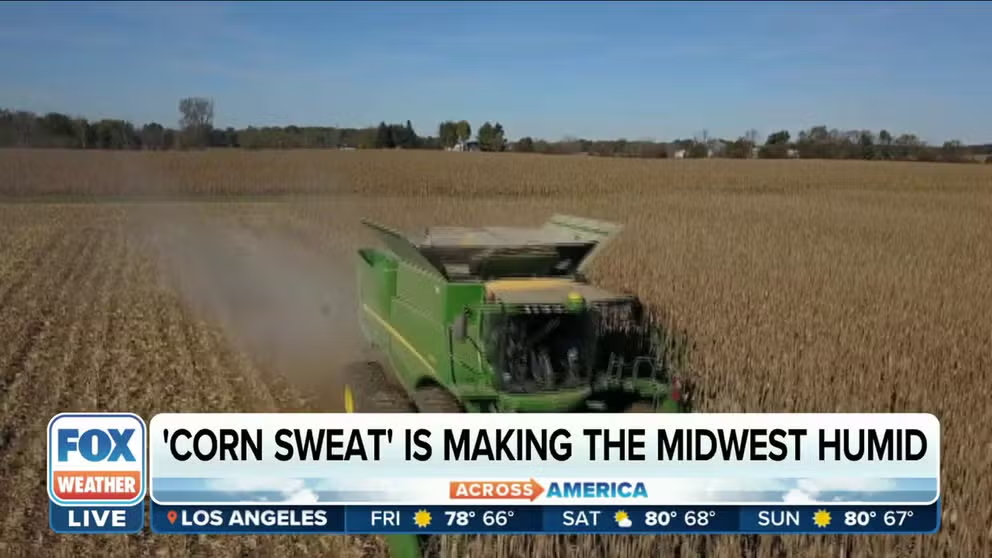'Corn sweat' in the Midwest can cause some of the most oppressive humidity in the US
Can you imagine stepping outside to a 90-degree dew point?
Corn causes Midwest to be humid by contributing moisture to atmosphere
Nebraska State Climate Office Agricultural Extension Climatologist Al Dutcher explains how ‘corn sweat’ impacts weather in parts of the Central U.S.
The humidity is no joke during the summer, especially if you live in the Midwest, South or East. Many days can have dew points in the 70s, indicating an oppressively humid air mass that leads to instant sweat the moment you walk outside. But at least you’ve never experienced a 90-degree dew point.
A phenomenon known as "corn sweat" can combine with summertime heat in the Midwest to make for some unbelievably humid conditions.
Clarion, Iowa, reported a dew point of 90 degrees at 2:15 p.m. Central time on July 28, 2021. The air temperature at that time was also 90 degrees, resulting in 100% relative humidity and a heat index of 132 degrees.
Some 130 miles west of Clarion in Maurice, Iowa, an even higher dew point of 91 degrees was recorded the previous evening, between 5-7 p.m. Central time on July 27, 2021. The 5 p.m. air temperature was 93 degrees, making the heat index an astounding 141 degrees.
According to an August 2011 blog post by weather historian Christopher Burt at Weather Underground, the highest dew point ever reliably measured in the United States was 91 degrees in Melbourne, Florida, at 2 p.m. Eastern time on July 12, 1987. That was accompanied by an air temperature of 95 degrees, so the heat index was a stifling 144 degrees (in case you were keeping score at home).
If the 91-degree dew point in Maurice, Iowa, from July 27, 2021, is confirmed as accurate, it would tie that unofficial record from Melbourne, Florida, in July 1987. It's unofficial because Burt noted in his blog that it had not been investigated for accuracy.
The dew point has also reached 90 degrees in the past in Louisiana (1987), Florida (1987) and Wisconsin (1995).
However, many meteorologists were skeptical of the 90-degree dew points reported in Iowa in July 2021. Daryl Herzmann, a systems analyst within the Department of Agronomy at Iowa State University and developer of the Iowa Environmental Mesonet website, tweeted that those observations were "standard failures for the sensor at extreme humidity/temperature levels."
Although the dew point might not have actually hit 90 degrees there, there were several more reliable weather stations in Iowa that reported dew points higher than 80 degrees July 27-28, 2021, and that's still downright brutal.
It’s so hot, even the corn sweats
Jamie Foxx or Milli Vanilli might try to blame it on something else, but we'll blame it on "corn sweat."
The farms of Iowa are the number-one supplier of America’s corn, so there’s obviously an abundance of cornfields all throughout the Hawkeye State. Corn (or any plant) pulls moisture out of the soil, and some of that moisture escapes through the corn's leaves and enters the surrounding air. This is called transpiration.
Just as humans sweat, or perspire, to cool down, plants are no different. The higher the air temperature, the more the plant will sweat, or transpire.
The transpired moisture will then evaporate off the plant's leaves to cool it down, just like how sweat evaporates off human skin. Evaporation is a cooling process.
Additional moisture also enters the air from lakes and other water sources in the area through evaporation. Combine all of this evaporation and transpiration, and you get evapotranspiration.
"Corn sweat" is simply a more colloquial way of referring to evapotranspiration in the vicinity of cornfields.
This process of evapotranspiration leads to increased moisture in the air near cornfields as the corn "sweats" to keep itself cool, ultimately leading to higher dew points in many areas surrounding the cornfields.

(FILE image)
What does an 80-plus-degree dew point really mean?
Dew points are used to figure out how much moisture is present in the air. In simplest terms, the dew point is the temperature to which the air must be cooled in order for it to become saturated. It provides a measure of the actual amount of water vapor in the air – so the higher the dew point, the more moisture in the air.
Once the air temperature and dew point meet, the air becomes saturated and the relative humidity reaches 100%. The dew point can never be higher than the air temperature.
Weather conditions affect everyone differently, but a good generalization is that dew points in the 50s or lower are comfortable for most people, 60s are humid and somewhat uncomfortable and 70s are oppressive and very uncomfortable. Once the dew point gets into the 80s – and even to around 90 degrees on these extremely rare instances – it's basically unfathomable. (You have never experienced that much humidity unless you live near a Midwestern cornfield or somewhere along the Gulf Coast.)

This table illustrates how muggy the air feels at various ranges of dew points.
(FOX Weather)
Burt noted in his August 2011 blog post that dew point records are particularly difficult to verify, but he said it can be assumed the highest-recorded dew points for most places east of the Great Plains are likely in the 77- to 85-degree range. For example, the record-high dew point in Philadelphia is 82 degrees from July 15, 1995, and the highest-ever dew point in Syracuse, New York, is 77 degrees from July 4, 1999.
Luckily, "corn sweat" isn't really a thing unless you live in the Midwest, a region covered in corn. The weather station in Clarion, Iowa, that reported a 90-degree dew point July 28, 2021, is located in the middle of a cornfield. The station in Maurice, Iowa, that observed a dew point of 91 degrees July 27, 2021, also appears to be surrounded by cornfields. We can certainly blame it on "corn sweat" here (and failing weather instruments).
